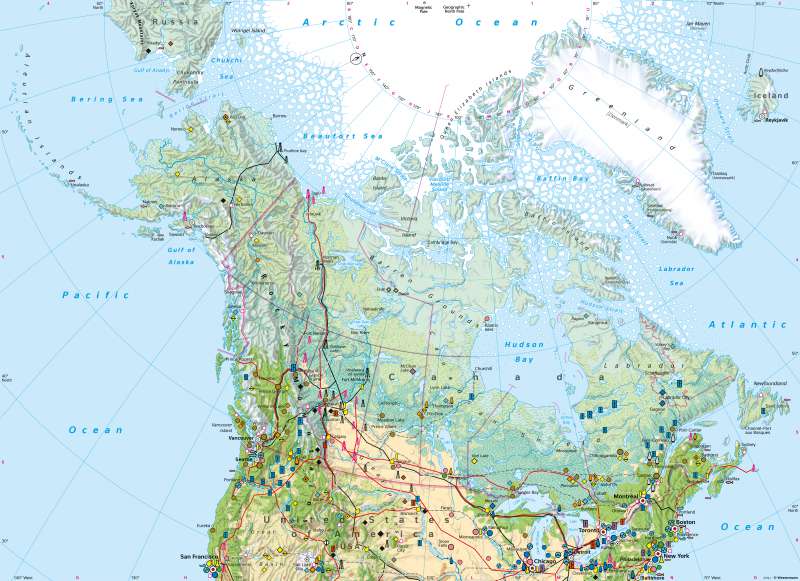North America (northern part) - Economy and land use
Economy and land use
978-3-14-100890-6 | Page 180 | Ill. 1

Overview
Due to their location in the high northern latitudes of the North American continent, Canada and Alaska have only limited opportunities for economic diversification. The largest portion of Canada lies north of the 50th parallel. In the West, the border to the United States runs along the 49th parallel north. Except for a narrow strip along the coast and the Alaskan peninsula, the state of Alaska lies north of the 60th parallel.
The economy of Canada
Canada ranks high among the world's leading suppliers of raw materials. Only the USA and Russia produce more natural gas, and Canada's oil reserves are second in size only to those of Saudi Arabia. Canada benefits significantly from the oil sands discovered in Alberta, the exploitation of which is growing increasingly profitable as prices continue to rise on the world oil market. This wealth and the potential for harnessing wind power make Canada a major energy exporter. Natural gas and petroleum pipelines convey these important resources primarily to Canada's neighbour to the south, the USA. Canada also ranks first in the production and processing of gold, uranium, zinc, nickel, lead, molybdenum, and copper as well as other metals and ores. The most important iron mining areas are located in the eastern provinces of Quebec and Newfoundland. Ontario, which borders Quebec to the west is the number-one producer of gold, while the largest uranium deposits are found in Saskatchewan. The industrial heart of Canada, the country with the second-largest landmass in the world next to Russia, beats in the East. The backbone of the local economy is composed of aluminium works and firms in the wood and paper industries. They profit from the fact that roughly 45 percent of the total area of Canada is covered by forests. There are also numerous wood- and paper-processing companies in western Canada. The automotive and aviation industries are also firmly established in Canada, as are the chemicals and electrical engineering sectors. One of the nation's most noteworthy growth industries is biotechnology. As is true of all advanced industrial nations, the service sector accounts for the largest share of gross domestic product in Canada as well. As centres of the service sector, Montreal, and Toronto, the two largest cities in the East, compare in importance to their U.S. counterparts New York, Boston, and Chicago, all of which are located in the same general region. Agriculture is also an important part of Canada's economic structure. Due to the unfavourable climate conditions, only the southern regions of the country are suitable for agricultural. Yet they are so productive that Canada is now one of the leading exporters of wheat in the world. Other mosaic tiles in the total economic picture are the fishing and fish processing industries, which benefit from the rich fishing grounds off the coast of Newfoundland.
The economy of Alaska
The Earth in Alaska is full of iron, copper, lead and other metals and ores. Yet environmental restrictions and the state's distance from the continental USA make exploitation of these resources unprofitable. One exception is gold, which has been mined in the region for more than a century and can be marketed profitably, as only small quantities must be transported.
The most important single sector the Alaskan economy is the oil industry. More than two-thirds of the known reserves in the oilfields of Prudhoe Bay have already been extracted, however. The Exxon Valdez oil spill of 1989 revealed just how sensitively Alaska's ecosystem can react to such influences. The shipping accident, which occurred near the port city of Valdez, resulted in the pollution of 2,000 kilometres of coastline. Opponents and advocates are still engaged in heated debate regarding the exploitation of Alaska's natural resources today.
The economy of Alaska
The Earth in Alaska is full of iron, copper, lead and other metals and ores. Yet environmental restrictions and the state's distance from the continental USA make exploitation of these resources unprofitable. One exception is gold, which has been mined in the region for more than a century and can be marketed profitably, as only small quantities must be transported.
The most important single sector the Alaskan economy is the oil industry. More than two-thirds of the known reserves in the oilfields of Prudhoe Bay have already been extracted, however. The Exxon Valdez oil spill of 1989 revealed just how sensitively Alaska's ecosystem can react to such influences. The shipping accident, which occurred near the port city of Valdez, resulted in the pollution of 2,000 kilometres of coastline. Opponents and advocates are still engaged in heated debate regarding the exploitation of Alaska's natural resources today.




